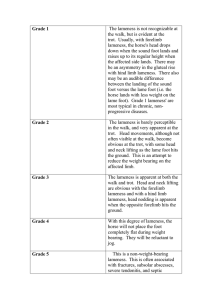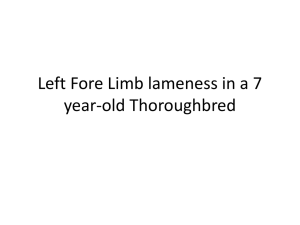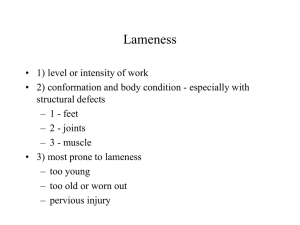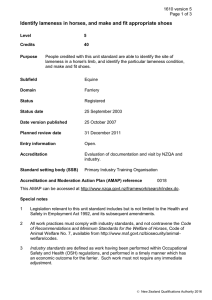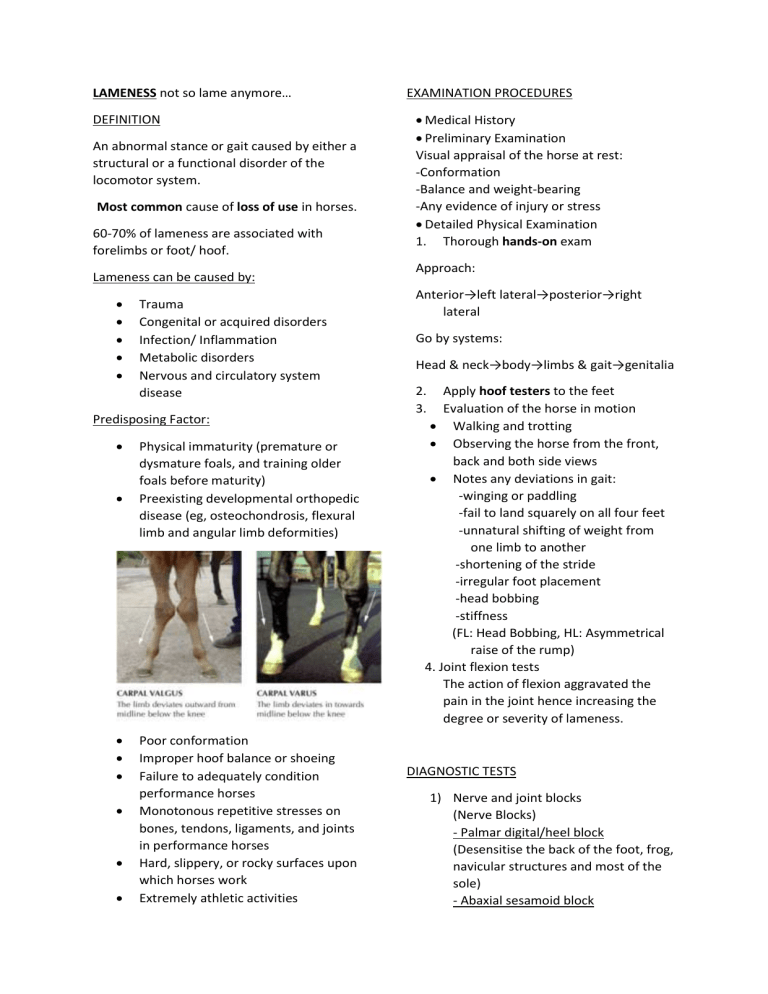
LAMENESS not so lame anymore… DEFINITION An abnormal stance or gait caused by either a structural or a functional disorder of the locomotor system. Most common cause of loss of use in horses. 60-70% of lameness are associated with forelimbs or foot/ hoof. Lameness can be caused by: Trauma Congenital or acquired disorders Infection/ Inflammation Metabolic disorders Nervous and circulatory system disease Predisposing Factor: Physical immaturity (premature or dysmature foals, and training older foals before maturity) Preexisting developmental orthopedic disease (eg, osteochondrosis, flexural limb and angular limb deformities) Poor conformation Improper hoof balance or shoeing Failure to adequately condition performance horses Monotonous repetitive stresses on bones, tendons, ligaments, and joints in performance horses Hard, slippery, or rocky surfaces upon which horses work Extremely athletic activities EXAMINATION PROCEDURES Medical History Preliminary Examination Visual appraisal of the horse at rest: -Conformation -Balance and weight-bearing -Any evidence of injury or stress Detailed Physical Examination 1. Thorough hands-on exam Approach: Anterior→left lateral→posterior→right lateral Go by systems: Head & neck→body→limbs & gait→genitalia 2. 3. Apply hoof testers to the feet Evaluation of the horse in motion Walking and trotting Observing the horse from the front, back and both side views Notes any deviations in gait: -winging or paddling -fail to land squarely on all four feet -unnatural shifting of weight from one limb to another -shortening of the stride -irregular foot placement -head bobbing -stiffness (FL: Head Bobbing, HL: Asymmetrical raise of the rump) 4. Joint flexion tests The action of flexion aggravated the pain in the joint hence increasing the degree or severity of lameness. DIAGNOSTIC TESTS 1) Nerve and joint blocks (Nerve Blocks) - Palmar digital/heel block (Desensitise the back of the foot, frog, navicular structures and most of the sole) - Abaxial sesamoid block (Abolishes sensation below the fetlock in the foot and pastern) - Low four point block (low six in the hind limb) (Abolishing sensation to the fetlock and below) - High four point block (Abolishes sensation from the cannon area down to the foot) (Joint Blocks (Synovial Blocks) - Coffin joint - Fetlock joint - Hock joint - Stifle joint 2) 3) 4) 5) Radiographs Ultrasound (sonography) Arthroscopy Blood, synovial (joint) fluid and tissue samples 6) Scintigraphy (nuclear scanning) The AAEP guidelines explain the grading system this way: Grade 0 Lameness not perceptible under any circumstances. Not Lame 1 Lameness is difficult to observe and is not consistently apparent, regardless of circumstances (e.g. under saddle, circling, inclines, hard surface, etc.). Lame inconsistent at any condition. 2 Lameness is difficult to observe at a walk or when trotting in a straight line but consistently apparent under certain 3 4 5 circumstances (e.g. weightcarrying, circling, inclines, hard surface, etc.). Lame easily seen during exercise, but difficult during simple task. Lame inconsistent at trot. Lameness is consistently observable at a trot under all circumstances. Lame consistent at trot Lameness is obvious at a walk. Lame consistent at walk Lameness produces minimal weight bearing in motion and/or at rest or a complete inability to move. Weight bearing *TREATMENT depends on aetiology, condition and severity.
